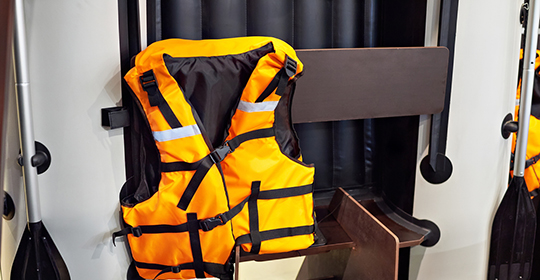Consider Which of These Marine Safety Devices You Need
By Ken Schultz
Apr 05, 2024
Consider which of these marine safety devices, both mandatory and not, you need according to your boat type and size, and the waters you’ll traverse
Marine safety devices are either required or advisable on all types of watercraft. Even if you only use a kayak or paddleboard, you must have a whistle (for signaling) and a PFD. There are more requirements and recommendations for larger boats, especially powered craft. Here’s a list of common marine safety devices; consider which of these you need according to your boat type and size, and the waters you’ll traverse.
Mandatory For Most Boats Per Local/Federal Law
1. Personal flotation device (PFD or “life jacket”). This qualifies as first among all marine life-saving essentials. It must be wearable, Coast Guard approved, appropriate in size per user, and is necessary for each individual on a boat.
2. Throwable flotation device. A buoyant ring or cushion that can be thrown to someone in the water, this is required for boats over a certain length.
3. Visual Distress Signal (VDS). This includes Coast Guard approved flares, smoke-emitting devices, and flags, which can be used day or night to attract attention. Flares are probably most common.
4. Sound-Producing Device. For the smallest of vessels this can be a whistle, for intermediate or larger ones this is a handheld air horn or permanently mounted trumpet-style horn capable of producing a 4-second blast audible for at least half a mile.
5. Fire Extinguisher. Required for boats over a certain size (and maybe two), marine fire extinguishers must be Coast Guard approved (and replaced when they reach their expiration date).
6. Navigation Lights. Used to indicate a boat’s presence and movement, these essential marine safety devices are fore and aft lights that must be used at night.

Mandatory or Advisable For Large Boats
Some safety equipment is required for large boats, including a life raft, lifeboat, backfire flame arrestor, and compartmental ventilation system. Advisable devices for large boats and those who venture great distances and through open seas include an emergency position-indicating radio beacon (EPIRB), and personal locator beacon (PRB).
Not Required But Advisable for Many Boats
1. Marine VHF Radio. This is necessary where cell phones don’t have a signal and for emergency communication.
2. Bilge Pump. This basic safety device is essential for removing water from a boat.
3. Anchor and Anchor Rope. Besides being useful for positioning a boat, you’ll especially want to deploy an anchor if the engine fails and you’re being carried away by wind and/or tide.
4. First Aid Kit. Buy one or make one but keep it in a watertight container.
5. Navigational Chart and Compass. Most boaters use an electronic device (or their mobile phone) for navigation, but if they conk out or have no signal you’ll be glad to have a chart and compass onboard.
6. Oar or Paddle. This is helpful for small boats in nearshore situations if a motor quits.
7. Other Items That Could Have Safety Value. Consider these good-to-have items: an emergency supply of water and food; durable waterproof rainsuit (jacket and bib); an emergency blanket; and reflective tape on the stern of a boat (also good for boats that are trailered).
Whatever marine safety devices you have, make sure that you maintain them and know how to use them properly, especially in an emergency.









